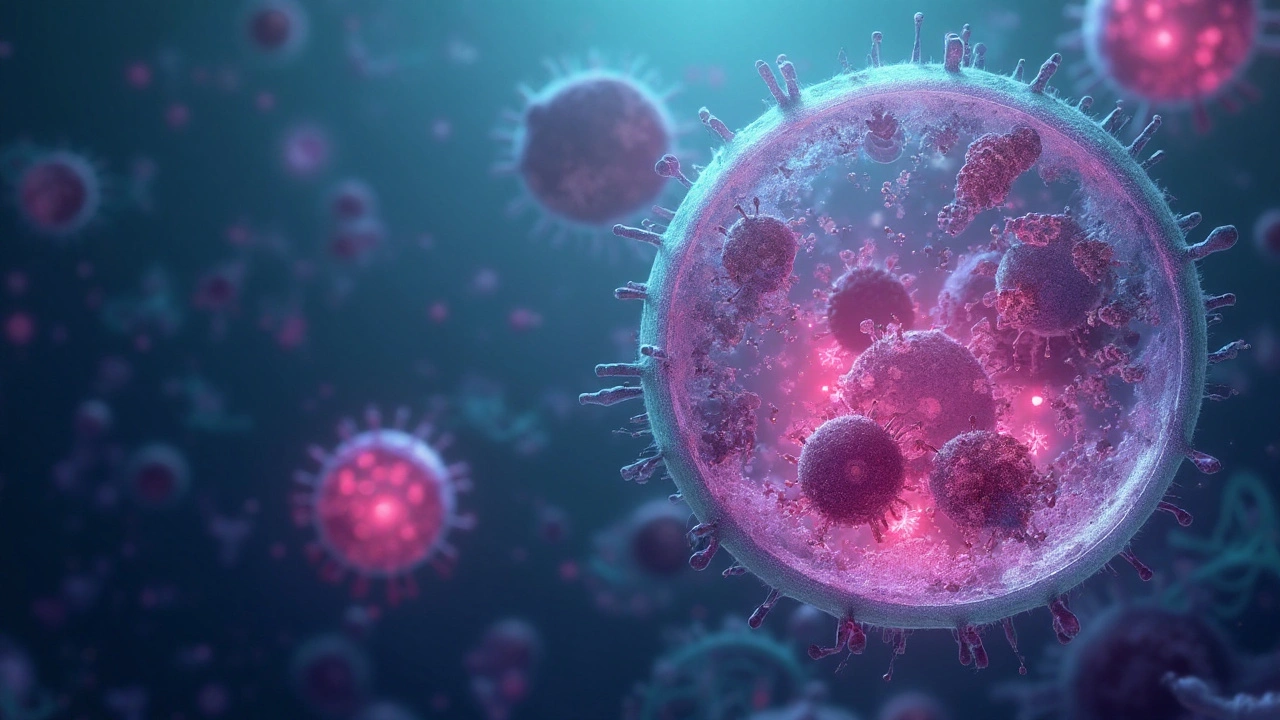Chlamydia trachomatis is a gram‑negative intracellular bacterium that causes the most commonly reported bacterial sexually transmitted infection (STI) worldwide. It invades epithelial cells of the genital tract, rectum, and eye, where it replicates in a unique "inclusion" vacuole. The organism’s ability to hide inside cells makes the Chlamydia immune response a key factor in disease outcome.
How Chlamydia Gets Inside Your Body
During vaginal, anal, or oral contact, elementary bodies-the infectious form of the bacterium-attach to host cell receptors such as heparan sulfate. Once bound, they are endocytosed and convert to the replicative "reticulate bodies" inside an inclusion. This stealthy lifecycle shields the pathogen from immediate detection by circulating antibodies.
What the Immune System Is
Immune system is a complex network of cells, tissues, and molecules that protects the body from infection and disease. It consists of two main arms: the innate (first‑line) response and the adaptive (specific) response. Both arms are activated when Chlamydia tries to establish an infection.
Innate Defenses: The First Line of Fight
When Chlamydia enters the genital mucosa, resident macrophages and neutrophils are the first responders. They release cytokines such as IL‑1β, IL‑6, and TNF‑α, which create an inflammatory environment meant to limit bacterial spread. However, the bacterium can suppress apoptosis, allowing it to persist inside the inclusion.
Adaptive Immunity: Tailored Attack
As the infection progresses, antigen‑presenting cells display Chlamydia peptides to CD4⁺ T cells. These helper cells orchestrate a Th1‑type response, secreting interferon‑γ (IFN‑γ) that activates infected epithelial cells to inhibit bacterial replication. CD8⁺ T cells can also recognize infected cells and kill them via perforin‑mediated pathways. Meanwhile, B cells produce antibodies-primarily IgA in mucosal secretions and IgG in serum-that neutralize extracellular elementary bodies, reducing transmission.
Immune Evasion Strategies Used by Chlamydia
Chlamydia employs several tricks to dodge the host’s defenses:
- Inclusion membrane proteins (e.g., IncA) modify host vesicle trafficking, preventing lysosomal fusion.
- The major outer membrane protein (MOMP) varies its surface epitopes, limiting effective antibody binding.
- By down‑regulating host apoptosis pathways, the bacterium extends its intracellular lifespan.
These tactics explain why many infections remain asymptomatic for weeks or months.

Clinical Consequences When the Immune System Can’t Clear the Infection
Untreated Chlamydia can ascend the reproductive tract, triggering pelvic inflammatory disease (PID). PID leads to scar tissue, increasing the risk of chronic pelvic pain, ectopic pregnancy, and infertility. In men, the bacterium can cause epididymitis, which also threatens fertility.
Treatment and Its Interaction With Immunity
The standard regimen-single dose of azithromycin 1g or a 7‑day course of doxycycline 100mg twice daily-effectively eradicates replicating bacteria. Antibiotics don’t directly boost immunity, but clearing the pathogen removes the ongoing immune suppression, allowing the immune system to reset. Reinfection rates are high (up to 15% within a year) because natural immunity after a single episode is weak; hence partner treatment and repeat testing are essential.
Public Health Measures and Future Directions
Routine STI screening for sexually active individuals under 30, combined with prompt partner notification, dramatically lowers community prevalence. Researchers are also pursuing a vaccine targeting conserved regions of MOMP and the polymorphic membrane protein (Pmp) family. Early‑phase trials show promising T‑cell mediated protection, but a licensed vaccine is still several years away.
Chlamydia vs. Gonorrhea: Immune Response Snapshot
| Attribute | Chlamydia trachomatis | Neisseria gonorrhoeae |
|---|---|---|
| Causative organism | Obligate intracellular bacterium | Facultative extracellular gram‑negative diplococcus |
| Typical incubation | 7-21days | 2-7days |
| Primary immune evasion | Inclusion membrane, antigenic variation | Pilin variation, IgA protease |
| Recommended antibiotic (UK) | Azithromycin 1gsingle dose or Doxycycline 100mgbid×7days | Ceftriaxone 500mgIMsingle dose + Azithromycin 1goral |
| Rate of asymptomatic infection | ≈70% in women, 50% in men | ≈50% in women, 10% in men |
Key Take‑aways
Chlamydia’s stealthy intracellular life forces the immune system to mount both innate and adaptive defenses, yet the response is often insufficient to prevent lingering infection. Understanding this dance helps explain why many cases slip under the radar, why complications arise, and why repeat testing after treatment is non‑negotiable. Staying informed, getting screened, and completing antibiotic courses remain the strongest weapons we have today.

Frequently Asked Questions
Can my body develop immunity after a Chlamydia infection?
Natural immunity to Chlamydia is weak. A single infection rarely prevents future bouts because the bacterium’s antigenic variation limits lasting antibody protection. That's why regular screening is essential even after successful treatment.
Why do many people with Chlamydia feel fine?
About 70% of women and half of men experience no symptoms. The pathogen lives inside cells, evading early detection, and the inflammatory response can be subtle. Without symptoms, the infection can silently cause damage over time.
How quickly do antibiotics work against Chlamydia?
Azithromycin clears most infections with a single dose, while doxycycline achieves a 97‑99% cure rate over a week. Symptoms may improve within a few days, but the bacteria are fully eradicated only after the full course.
What complications can arise from untreated Chlamydia?
In women, the infection can ascend to cause pelvic inflammatory disease, leading to scarring, chronic pain, ectopic pregnancy, and infertility. Men may develop epididymitis, which also threatens fertility. Rarely, the bacterium spreads to the bloodstream causing arthritis or conjunctivitis.
Is there a vaccine for Chlamydia on the horizon?
Early‑phase trials of a subunit vaccine targeting the conserved MOMP protein show promising T‑cell responses, but a widely available vaccine is still years away. Ongoing research focuses on combining multiple antigens to overcome the bacterium’s variability.

All Comments
Uju Okonkwo September 25, 2025
Great overview! I love how you broke down the innate and adaptive arms of immunity and linked them directly to Chlamydia’s life cycle. It really helps readers see why the infection can linger without obvious symptoms. For anyone getting screened, remembering that the immune system can be tricked is a solid reason to follow up on treatment. Keep spreading this kind of clear, actionable info – it makes a difference. 🌟
allen doroteo September 26, 2025
Wow, what a "perfect" piece, huh? Like, really, who needs a vaccine when we have antibiotics? The whole immune thing is just overblown. Anyway, it’s all about the meds, right?
Corey Jost September 26, 2025
Honestly, the immune response to Chlamydia is a textbook case of a biological arms race that has been raging for millennia, and the nuances are far more intricate than a simple two‑paragraph summary can capture. First, the elementary bodies must navigate a hostile mucosal environment, employing heparan sulfate receptors to gain entry, which is a clever subversion of host cell adhesion mechanisms. Once inside, the reticulate bodies replicate within the inclusion, a membrane-bound niche that cleverly evades lysosomal fusion, a point that underscores the sophistication of bacterial survival strategies.
Second, the innate immune system launches an immediate, yet often insufficient, assault. Neutrophils and macrophages unleash a barrage of cytokines-IL‑1β, IL‑6, TNF‑α-creating an inflammatory milieu. However, Chlamydia can actively dampen apoptosis, buying itself time to proliferate.
Third, the adaptive arm takes over, with dendritic cells presenting antigens to CD4⁺ Th1 cells, which then secrete interferon‑γ to activate antimicrobial pathways in epithelial cells. CD8⁺ cytotoxic T cells also contribute by recognizing infected host cells and delivering perforin and granzyme punches.
Fourth, B cells generate antibodies, primarily IgA at mucosal surfaces and IgG systemically, yet the bacterium’s antigenic variation-especially in the major outer membrane protein (MOMP)-means these antibodies often miss their mark.
Fifth, the immune evasion tactics are not limited to inclusion membranes; Chlamydia also manipulates host vesicle trafficking via Inc proteins, suppresses host signaling pathways, and even rewires metabolism to favor its own replication.
Sixth, the clinical sequelae are a direct consequence of this incomplete immune clearance. Pelvic inflammatory disease, scarring, ectopic pregnancy, and infertility in women, and epididymitis in men, all stem from persistent low‑grade inflammation.
Seventh, treatment with azithromycin or doxycycline wipes out the replicating bacteria but does little to restore the immune equilibrium that has been skewed, which explains the high reinfection rates.
Eighth, public health measures-screening, partner notification, repeat testing-are essential because natural immunity remains weak after a single infection.
Ninth, vaccine development is promising yet hampered by the very same antigenic variability that confounds natural immunity; targeting conserved regions of MOMP and polymorphic membrane proteins could finally tip the balance.
Tenth, comparing Chlamydia to Gonorrhea highlights divergent immune strategies: the former is intracellular and relies on inclusion‑mediated evasion, while the latter employs IgA proteases and pilin variation.
Eleventh, the takeaway is clear: we need a multipronged approach that combines effective antibiotics, robust screening programs, and eventually a vaccine that can outmaneuver Chlamydia’s evasive tactics.
Twelfth, until such a vaccine arrives, education and adherence to treatment protocols remain our best defense.
Thirteenth, let’s not forget the psychosocial impact of STI stigma, which can deter individuals from seeking care, perpetuating the cycle.
Fourteenth, researchers must continue to dissect the host‑pathogen interaction at the molecular level to uncover novel therapeutic targets.
Fifteenth, in the meantime, clinicians should counsel patients about the possibility of asymptomatic infection and the importance of routine retesting.
Finally, this comprehensive understanding underscores why Chlamydia remains a public health challenge and why interdisciplinary efforts are crucial to curb its spread.
Nick Ward September 26, 2025
Thanks for the detailed breakdown! It’s nice to see the science put into plain language. 😊
Rajeshwar N. September 26, 2025
Let’s not get carried away praising antibiotics. Sure, they clear the bug, but they also push resistance and do nothing for the immune dysregulation Chlamydia leaves behind. The article glosses over how the pathogen’s inclusion alters host signaling, which can have lingering effects beyond the infection.
Louis Antonio September 26, 2025
Exactly, the immune suppression isn’t just a side note. The bacteria’s ability to down‑regulate apoptosis means infected cells become reservoirs, and that’s why reinfection rates stay high. A vaccine targeting those conserved inclusion proteins could be a game‑changer.
Kyle Salisbury September 26, 2025
From a cultural standpoint, many communities still view STI testing as taboo, which hinders early detection. Sharing this info in local languages could improve uptake.
Angie Robinson September 26, 2025
This post reads like a textbook, but real‑world data shows that many clinics miss asymptomatic cases because they don’t follow up with partner notification. The system needs stricter enforcement.
Khalil BB September 26, 2025
Sure, but why bother with all this when a single dose of azithro does the trick?
Keri Shrable September 26, 2025
Important info, thanks!
Destiny Hixon September 26, 2025
We gotta keep it real – not everyone wants to hear boring med talk. Make it pop!
mike brown September 26, 2025
Honestly, all this science jargon is overkill. People just need the quick fix.
shawn micheal September 27, 2025
Love that you’re spreading awareness! Keep the community informed and encourage regular check‑ups. It’s the little steps that protect us all.
Stephen Jahl September 27, 2025
From a mechanistic perspective, the pathophysiological interplay between host immunomodulatory cascades and Chlamydia’s inclusion membrane proteins necessitates a paradigm shift towards adjunctive immunotherapeutic strategies, transcending the simplistic reliance on antimicrobial monotherapy.
Louis Robert September 27, 2025
Well‑summarized. Thanks for the concise overview.